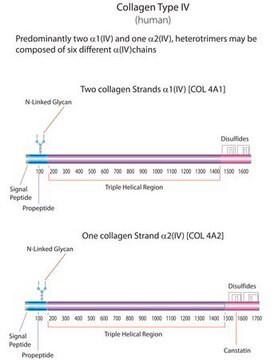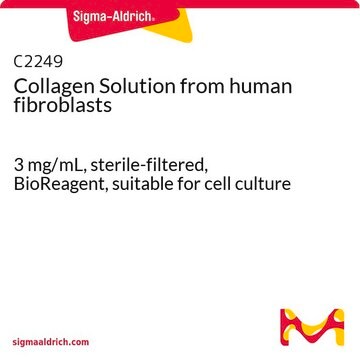C6745
Human Collagen Type IV
from human cell culture, liquid, 0.3 mg/mL, suitable for cell culture
About This Item
Recommended Products
product name
Collagen Type IV from human cell culture, Bornstein and Traub Type IV, 0.3 mg/mL, sterile-filtered, BioReagent, suitable for cell culture
biological source
human cell culture
Quality Level
sterility
sterile-filtered
product line
BioReagent
form
solution
mol wt
170—180 kDa
packaging
pkg of 1 mL
concentration
0.3 mg/mL
technique(s)
cell culture | mammalian: suitable
surface coverage
6‑10 μg/cm2
impurities
HBSAG, none detected
HCV, none detected
HIV-1/HIV-2, none detected
NCBI accession no.
UniProt accession no.
Binding Specificity
Peptide Source: Laminin
Peptide Source: Nidogen
shipped in
dry ice
storage temp.
−20°C
Gene Information
human ... COL4A1(1282)
Related Categories
General description
Collagen IV is a heterotrimeric molecules containing two α1-like and one α2-like chain. It is considered essential for completion of embryogenesis and is necessary for proper tissue organization and structural integrity. It is used in vitro as a substrate to enhance adherence and proliferation of many cell types. Produced by human fibroblasts and epithelial cells, Collagen IV is then purified biochemically and provided as a sterile solution at a concentration of 0.3mg/ml in 25% acetic acid.
Application
Biochem/physiol Actions
Features and Benefits
- This Collagen Type IV product is generated by human fibroblasts and epithelial cells in a co-culture system, which produces an ECM in vitro.
- The Collagen Type IV is then purified biochemically.
- It is sterilized by dialysis in an acetic acid and 0.5% chloroform solution and is supplied sterile at a concentration of ~0.3 mg/ml in 25% acetic acid.
Storage Class Code
11 - Combustible Solids
WGK
WGK 1
Flash Point(F)
Not applicable
Flash Point(C)
Not applicable
Personal Protective Equipment
Certificates of Analysis (COA)
Search for Certificates of Analysis (COA) by entering the products Lot/Batch Number. Lot and Batch Numbers can be found on a product’s label following the words ‘Lot’ or ‘Batch’.
Already Own This Product?
Find documentation for the products that you have recently purchased in the Document Library.
Customers Also Viewed
Articles
Extracellular matrix proteins such as laminin, collagen, and fibronectin can be used as cell attachment substrates in cell culture.
Extracellular matrix proteins such as laminin, collagen, and fibronectin can be used as cell attachment substrates in cell culture.
Extracellular matrix proteins such as laminin, collagen, and fibronectin can be used as cell attachment substrates in cell culture.
Extracellular matrix proteins such as laminin, collagen, and fibronectin can be used as cell attachment substrates in cell culture.
Our team of scientists has experience in all areas of research including Life Science, Material Science, Chemical Synthesis, Chromatography, Analytical and many others.
Contact Technical Service









